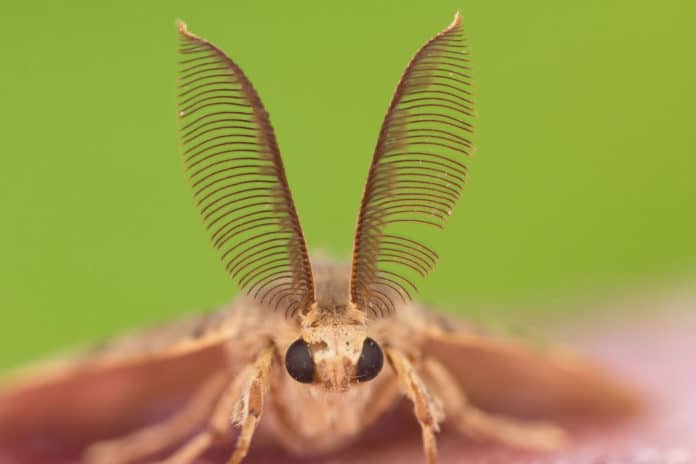Since bats developed echolocation 65 million years ago, bats and moths have been engaged in an acoustic arms race between predator and prey. Bats prey on moths, so they’ve evolved various defenses, but the scales on a moth’s wing hold the secret to altering noise-canceling technology.
Experts at the University of Bristol have discovered that the scales on moth wings act as excellent sound absorbers even when placed on an artificial surface. Moth wings act as natural metamaterials. They offer functionality as efficient sound absorbers through the action of the numerous resonant scales that decorate their wing membrane.
In this new study, scientists found that moth wings are efficient sound absorbers- they can potentially reduce reflection from an acoustically hard surface by up to 87% at the lowest frequency tested (20 kHz), despite a thickness to wavelength ratio of up to 1/50.
Prof Marc Holderied of Bristol’s School of Biological Sciences said: “What we needed to know first was how well these moth scales would perform if they were in front of an acoustically highly reflective surface, such as a wall.”
“We also needed to find out how absorption mechanisms might change when the scales interact with this surface.”
Scientists tested this by placing small sections of moth wings on an aluminum disc. They then systematically tested how the orientation of the wing with respect to the incoming sound and the removal of scale layers affected absorption. They found that even when on top of a solid acoustic substrate, the wings absorb as much as 87% of the incoming sound energy. The effect is also broadband and omnidirectional, covering various frequencies and sound incident angles.
Lead author Dr. Thomas Neil said, “What is even more impressive is that the wings are doing this while being incredibly thin, with the scale layer being only 1/50th of the thickness of the wavelength of the sound that they are absorbing. This extraordinary performance qualifies the moth wing as a naturally occurring acoustic absorbing metasurface, a material with unique properties and capabilities that are impossible to create using conventional materials.”
In noise control applications, a perfect metasurface absorber would have the desirable traits of not only mitigating unwanted sound but also being much thinner than the wavelengths of interest. Such deep-subwavelength performance is challenging to achieve technologically. Yet, as natural metamaterials, moth wings offer functionality as efficient sound absorbers through the action of the numerous resonant scales that decorate their wing membrane.
Scientists plan to replicate the sound-absorbing performance by designing and building prototypes based on the sound-absorbing mechanisms of the moth. The absorption in moth wing scales they have identified is all in the ultrasonic frequency range, which is above what humans can hear. Their next task is to create a framework that can operate at lower frequencies while maintaining the moth’s ultrathin construction.
Prof Holderied concluded: “Moths will inspire the next generation of sound-absorbing materials.
“New research has shown that one day it will be possible to adorn the walls of your house with ultrathin sound absorbing wallpaper, using a design that copies the mechanisms that give moths stealth acoustic camouflage.”
Journal Reference:
- Thomas R. Neil, Zhiyuan Shen, et al. Moth wings as sound absorber metasurface. DOI: 10.1098/rspa.2022.0046
